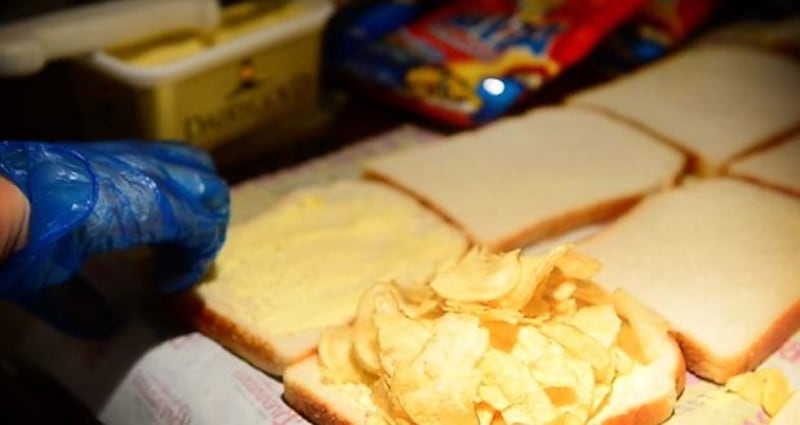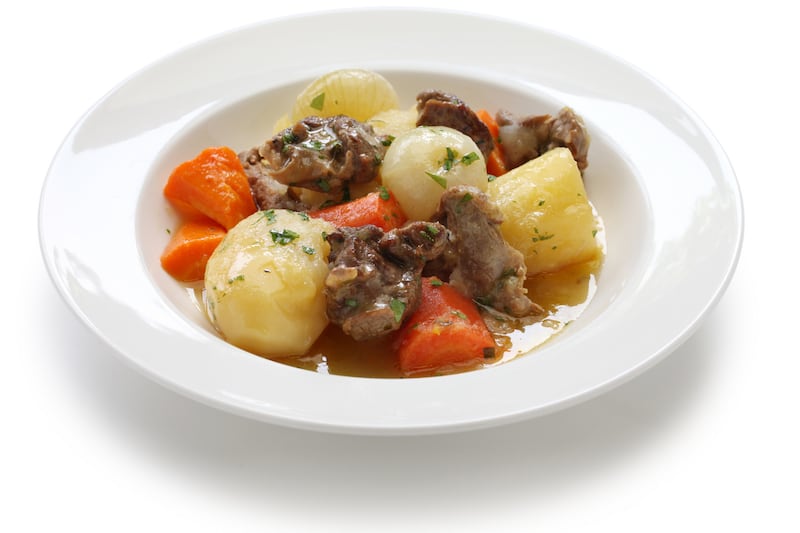Move over King, you may have the title, but when it comes to that celebrated Irish snack, the crisp sandwich, Tayto rules the roost. The choice of Aer Lingus when it put the national delicacy on in-flight menus, Mr Tayto is the secret to a satisfyingly crunchy and salty sambo, according to readers who responded to our request for insights into how to make the best version.
“I’m far too fond of a crisp sandwich and am very precious about them,” says David Farrell. “For me it has to be Tayto cheese and onion crisps, which are carefully laid across Irish Pride Big Toast bread and then crushed between the two slices. Where the controversy lies for me is I pop both slices of bread in the toaster beforehand, getting them lightly toasted, with the slightest hint of brown. I want to have a slight crunch and some warmth to get the butter all melty.”
Pat O’Gorman and family put their own spin on the sandwich. “As my family grew we enjoyed certain traditions. Coddle on Saturday, pizza on Friday, roast on Sunday. But the one tradition that has lasted us is the O’Gorman sandwich.” As well as crisps on buttered white bread, this one has optional slices of apple, and is “washed down with tea, no fancy drinks, no sauces or mayonnaise.”

Writing from Brazil, Peter Maher takes the crisp sandwich to gastronomic heights. Specifying Brennan’s bread and Tayto cheese and onion, these are his instructions: “Spread some Dijon mustard on one slice, add the crisps and sprinkle on some Parmesan cheese, crack some black pepper and a few sprinkles of hot sauce ... perfect.”
Fiona McDonagh goes a bit rogue with her crisp sandwich. “Salt and vinegar Tayto is a must, on sliced brown bread, with one slice of smoked ham, thinly sliced scallions, and mayonnaise on the bread.”
Brid Dunne opts for simplicity. “This feels like it could be easily over complicated and to be honest I’m rather concerned at what this will open up. The sandwich must be only made from very fresh Brennan’s white bread, Kerrygold butter softened at room temperature and cheese and onion Tayto. Butter each piece of bread, add a heap of Tayto to one, arrange the other on top and give it a good squish down. Cut in half into rectangles and enjoy. I cannot honestly understand how anyone could make this any other way.”
Irish stew
If the vagaries of the crisp sandwich are a bit of an eye opener, the personal interpretations of what makes a good Irish stew are even more varied. Some call for lamb neck meat, others prefer cubed shoulder, and if you find yourself asking, what would Darina do, the answer is gigot chops. Pearl barley can be added as well as potatoes, to thicken the stew, and purists add the potatoes at two stages of the cooking process, so some melt into the gravy and others retain some bite.

When we asked where to get a good Irish stew, recommendations flowed in for the version served at Kavanagh’s Marino House in Dublin 3. Suzy Kavanagh, the chef at the family owned pub, revealed how she makes it. “ I use diced mutton, and I get lamb bones too and roast them.”
Kavanagh simmers the diced mutton in water for two to two and a half hours, then stores the meat, in the cooking water, overnight in the fridge. “The fat will solidify and you can lift it off,” she says. She then softens a mixture of chopped carrots, onions, leeks and celery, and adds the cooking water from the lamb, and the roasted lamb bones, along with Maris Piper potatoes. Seasoning is white pepper and a big sprig of fresh thyme. “The diced lamb goes in at the end and you cook it low and slow,” she says. The lamb bones and the thyme sprig are removed before serving the stew.
Ballymaloe trained chef Fiona Staunton, who runs an online and workplace nutrition and cooking mentoring business, Fiona’s Food For Life, makes an Irish stew that draws on several recipes. “I make a blend of my own, my mother-in-law’s and my Ballymaloe trained one. I use gigot chops, lots of onions, carrots, parsnips, potatoes, pearl barley and liquid aminos.” Liquid what? A liquid seasoning that is source of umami and an alternative to soy sauce, Google tells me. And you can buy it at Tesco and Holland & Barrett.
Colcannon
Ida Milne, writing from Co Carlow, has an interesting take on another Irish traditional favourite, colcannon. “I’m a zealot for a form of colcannon from north Wexford. Layer chopped peeled potatoes, an onion and a parsnip in a saucepan, and top with a dome of layers of white cabbage, the whole leaves. In the traditional recipe, you add a little over a mug of water, and seal with a lid of parchment paper and string. Simmer very slowly for about an hour. You’ll know by the change in smell, to a sort of vegetable caramel, that it’s ready. Add white pepper (trust me) and salt and butter. It’s exquisite, a complex flavour that needs nothing else.”

Coddle
Coddle may be a Dublin speciality, but its charm has spread far and wide. Imelda Murphy, writing from Co Tipperary, says: “Me ma made a great coddle, she would send one of us to the shops to get her a bunch of parsley, thyme and a few onions, then around to the butchers for two pounds of sausages and rashers. She would sit at her kitchen table peeling the potatoes for her Dublin Coddle. She didn’t do carrots, in the recipe she got from her mother. She would be 100 years old this year, had she lived. We will be honouring her in our kitchen during the year, sending her great grandkids down to the butchers, and having a pot of her coddle on the cooker.”
Paul Tyrrell, from Co Dublin, has his own recipe for what he calls upmarket coddle. “When I was a child, we had coddle twice a week during the winter. It was made with Gramby sausages, streaky bacon, onions, spuds and the secret ingredient was a celery stock cube. Today I make it with Superquinn sausages, ham pieces, onions, a packet of potato soup, and a chicken stock cube. I cook the potatoes separately.”










